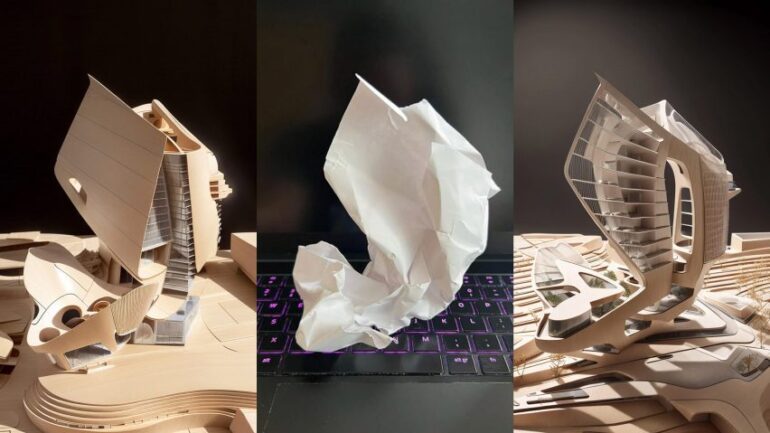TL;DR:
- Designer Tim Fu employs LookX, an AI tool trained on architecture, to create building models inspired by Frank Gehry and Zaha Hadid.
- LookX, an AI-generated content platform, offers specialized training on an architectural database called ArchiNet.
- Fu showcases the AI’s ability to produce refined results and resolved geometry, surpassing existing AI tools.
- LookX’s Explore mode allows users to select foundations, style models, upload images, and adjust control parameters.
- Fu believes LookX has the potential to revolutionize the architecture industry and surpass existing AI platforms.
- LookX’s Inspiration Generator, Model Training, and Sharing Community modules empower users to train and share their own AI models.
- The integration of AI tools like LookX in architecture studios, including Zaha Hadid, has become increasingly prevalent.
- LookX opens up new possibilities for architectural design and visualization, with applications ranging from sketches to massing renders.
Main AI News:
Designer Tim Fu has harnessed the power of LookX, an artificial intelligence (AI) tool focused on architecture, to transform crumpled paper into remarkable building models reminiscent of renowned architects Frank Gehry and Zaha Hadid. LookX, a newly launched platform, serves as an AI-generated content (AIGC) tool specifically tailored for architecture enthusiasts. It is trained on ArchiNet, an extensive architectural database, and fortified with industry semantics and annotations, as stated by LookX. By integrating multimodality and self-developed algorithms, this sophisticated model extends its applications throughout the field of architecture.
What sets LookX apart from existing AI tools is its specialization in architecture, according to Fu, who works as a designer for Zaha Hadid. Unlike Midjourney, DALL-E, or Stable Diffusion, LookX’s architecture-focused training equips it with enhanced capabilities to produce refined results and resolved geometry. Fu elaborated on this distinction in an interview with Dezeen. For his project, Fu utilized LookX to conceive a series of buildings, drawing inspiration from both Gehry’s iconic “squashed brown paper bag” design for the UTS Business School and a memorable episode of The Simpsons referencing it.

He also created an AI-generated design using the prompt OMA. Source: dezeen.com
Fu’s motivation behind this project stemmed from the recognition of Gehry’s legacy in crumpled paper design, immortalized in The Simpsons, as well as his desire to showcase the AI’s ability to interpret arbitrary inputs and generate highly refined outcomes. He aimed to highlight the interplay between whimsicality and intention in the design process. Leveraging LookX’s flexible Explore mode, Fu created designs reminiscent of Gehry, as well as architectural studios such as Zaha Hadid Architects, SANAA, OMA, and Santiago Calatrava. The Explore mode allows users to select foundations and style models, upload images, enter keywords, and adjust control parameters.
Fu revealed that he employed one of LookX’s localized clusters of machine learning algorithms known as LoRA (low-rank adaptation) models. He specifically chose a model trained for architecture, encompassing materials like wood and acrylic. Combining this model with the primary one, Fu generated images based solely on photographs of crumpled papers. LookX comprises three core modules: Inspiration Generator, Model Training, and Sharing Community. Users have the opportunity to train their own AI models and share them within the platform.
Furthermore, Fu utilized LookX to create visual representations of architectural models based on sketches and massing, as well as renders derived from massing. While Fu acknowledged Stable Diffusion as the closest existing AI platform, he asserted that its quality falls short in comparison. Stable Diffusion ControlNet operates by extracting contours from input image geometry and generating Stable Diffusion image results, akin to the LookX algorithm. However, according to Fu, its output quality is inferior.
Describing LookX as the “Midjourney killer” for the architecture industry, Fu expressed his belief in its ongoing development and immense potential. He emphasized the need for a more advanced AI tool in the field of architecture, and LookX seems to be fulfilling that role. With promising prospects for the present and future, LookX holds great promise for further advancements in the industry. Several architecture studios, including Zaha Hadid, have already integrated AI into their work processes. Patrik Schumacher, principal at Zaha Hadid, revealed in a roundtable discussion that the studio employs AI-generated images in the development of “most” projects. Recently, architecture studio Hickok Cole unveiled images of a mixed-use building featuring a green roof and a swimming pool, designed using ChatGPT.




Santiago Calatrava’s designs informed another building. Source: dezeen.com
Conclusion:
The introduction of LookX, an AI tool trained specifically on architecture, brings forth a paradigm shift in the market. Its capability to generate refined architectural models with resolved geometry surpasses existing AI tools. LookX’s Explore mode and user-centric modules empower designers to create unique and impressive designs. This innovation presents a tremendous opportunity for architecture studios and professionals to explore new avenues of creativity, streamlining their design processes and enhancing visualizations. By leveraging LookX and similar AI platforms, the architecture market can embrace cutting-edge technology to drive innovation and unlock untapped potential in the industry.

